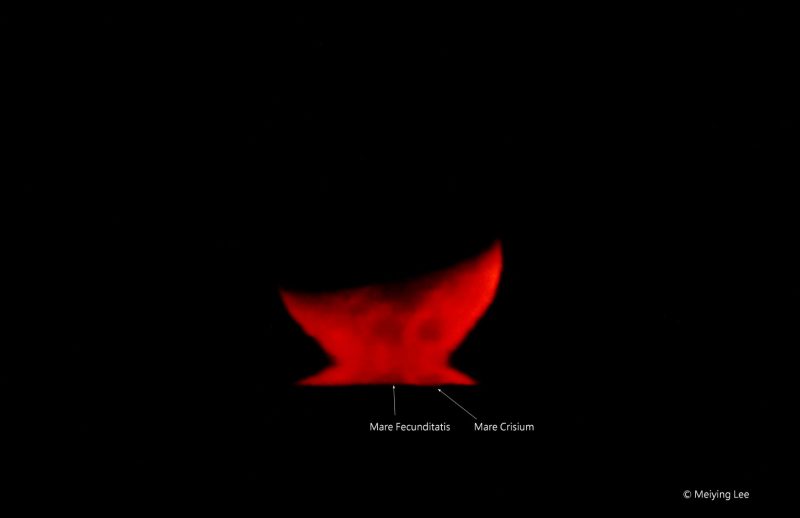What is an omega moonset?
Meiying Lee in Taipei, Taiwan has contributed many wonderful images to EarthSky’s community photo page. She captured these images – and created this video – of the omega moonset on November 10, 2021. That’s the name for a moonset (or sunset) where the moon (or sun) appears to spread out as it meets the horizon. It’s often compared to an Etruscan vase, or the Greek letter omega. Meiying captured such a moonset in the process of continuous change. She wrote:
Continuous change of the omega moon inferior mirage. The inferior mirage of celestial bodies rising or falling from the sea level is the most special and beautiful mirage. This is a special phenomenon that occurs when there is a low-density layer of hot air on the surface of the earth or ocean due to refraction. The most common one is the sun’s inferior mirage.
The weather was good on November 10, and I was lucky enough to meet the rare inferior mirage of the sinking moon! When the moon is very close to the sea level, the inverted virtual image below will form and slowly rise and connect with the upright image above to form a rare sight like an Etruscan vase, or the Greek letter omega!

Explaining omega moons and suns
Les Cowley at the website Atmospheric Optics explains omega sunsets this way. Omega moons would have the same explanation:
As the sun descends a second sun rises from the water. Eventually the two join at a red hued vertically stretched ‘stem.’ Jules Verne likened this appearance to an Etruscan vase. The stem shortens and thickens until the two suns appear like a Greek letter omega …
The lower sun is not a reflection from the water. It is an ‘inferior mirage’, so named not from any poverty in appearance but because the miraged sun is below the ‘real’ one. The lower sun is an inverted image produced by refraction by a layer of warmer and less dense air close to the ocean surface. The discus shape is a combination of the upper limb of the erect sun and an inverted image of it beneath.
Click here for Les Cowley’s detailed explanation of Omega suns and moons
As Meiying points out in the image below, the omega moonset is particularly wonderful because you can use the lunar surface features to confirm the mirage within its inverted shape.

Bottom line: Omega moonset, captured November 10, 2021, by Meiying Lee.
The post An omega moonset’s continuous change first appeared on EarthSky.
from EarthSky https://ift.tt/3H98ZbU
What is an omega moonset?
Meiying Lee in Taipei, Taiwan has contributed many wonderful images to EarthSky’s community photo page. She captured these images – and created this video – of the omega moonset on November 10, 2021. That’s the name for a moonset (or sunset) where the moon (or sun) appears to spread out as it meets the horizon. It’s often compared to an Etruscan vase, or the Greek letter omega. Meiying captured such a moonset in the process of continuous change. She wrote:
Continuous change of the omega moon inferior mirage. The inferior mirage of celestial bodies rising or falling from the sea level is the most special and beautiful mirage. This is a special phenomenon that occurs when there is a low-density layer of hot air on the surface of the earth or ocean due to refraction. The most common one is the sun’s inferior mirage.
The weather was good on November 10, and I was lucky enough to meet the rare inferior mirage of the sinking moon! When the moon is very close to the sea level, the inverted virtual image below will form and slowly rise and connect with the upright image above to form a rare sight like an Etruscan vase, or the Greek letter omega!

Explaining omega moons and suns
Les Cowley at the website Atmospheric Optics explains omega sunsets this way. Omega moons would have the same explanation:
As the sun descends a second sun rises from the water. Eventually the two join at a red hued vertically stretched ‘stem.’ Jules Verne likened this appearance to an Etruscan vase. The stem shortens and thickens until the two suns appear like a Greek letter omega …
The lower sun is not a reflection from the water. It is an ‘inferior mirage’, so named not from any poverty in appearance but because the miraged sun is below the ‘real’ one. The lower sun is an inverted image produced by refraction by a layer of warmer and less dense air close to the ocean surface. The discus shape is a combination of the upper limb of the erect sun and an inverted image of it beneath.
Click here for Les Cowley’s detailed explanation of Omega suns and moons
As Meiying points out in the image below, the omega moonset is particularly wonderful because you can use the lunar surface features to confirm the mirage within its inverted shape.

Bottom line: Omega moonset, captured November 10, 2021, by Meiying Lee.
The post An omega moonset’s continuous change first appeared on EarthSky.
from EarthSky https://ift.tt/3H98ZbU

Aucun commentaire:
Enregistrer un commentaire